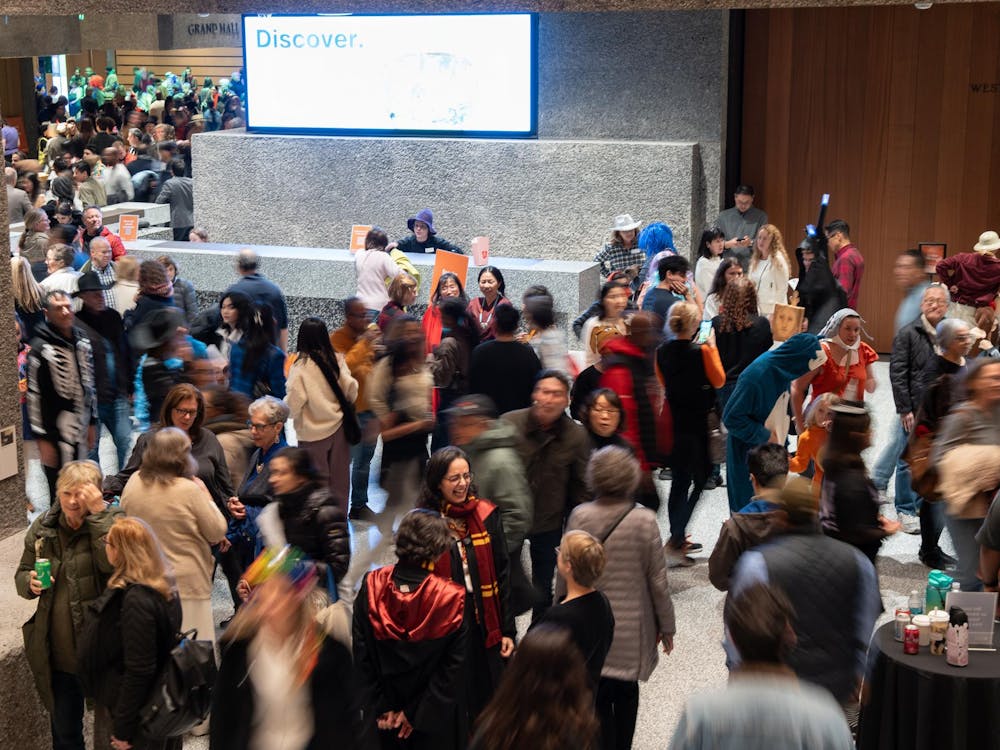In the Art of the Ancient Americas pavilion at the new Princeton University Art Museum, the first thing one notices is the crowded, dense displays in glass cases wrapping around the museum’s central Grand Hall.

Displays surrounding the Grand Hall.
Cynthia Torres / The Daily Princetonian
But while plates are next to plates and vases next to vases, the dense displays appear less important than the thoughtfully displayed objects found in the rest of the pavilion that are given appropriate space, sometimes with 360 degrees of viewing.
“The Princeton Vase,” one of the museum’s most iconic pieces, has its own dedicated case in the pavilion. A Mayan chocolate-drinking cup inscribed in codex style, the vase presents a story depicting human sacrifice, calling upon the viewer to continually rotate around the vase and reveal the story told through rich iconography.

"The Princeton Vase" displayed in the Art of the Ancient Americas.
Cynthia Torres / The Daily Princetonian
The pavilion also features several other Mayan drinking cups, called uk’ibs, with inscribed images and a story told by rotating the vase. Some other Mayan drinking cups tell more pivotal stories for Mayan history. One uk’ib depicts the story of the infamous defeat of major underworld Gods, Hunahpu and Xbalanque, and another tells the story of the annual cycle of rebirth of the maize god, Hun Hunahpu. The displayed uk’ibs date back to the second half of the first millennium.
Outside of ceramic vases and plates, ceramic figures are on display throughout the pavilion. The Jaina figurines were particularly eye-catching, displayed in a line directly at eye level with their earth tones contrasting with the navy blue wall behind them.

Jaina figurines.
Cynthia Torres / The Daily Princetonian
The Jaina figurines were from 600–900 A.D. and associated with the islands of Jaina and Uaymil off the west coast of Mexico. Each of the figures represented different noble Mayans with various court positions and genders. The didactic explains that these figurines were often unearthed by looters and presumably associated with burials.
Museum visitors Kruti Ramani and Sabrina Yanetta described the collection as “very expansive.”
“There’s so much to see, to look at. You see it once, and then you walk around the second time you see stuff you didn't see the first time,” Yanetta said, describing the circles she walked in the relatively small gallery.
Representing over 5,000 years of art crafted by indigenous Americans from Alaska to Chile, the collection varied across many empires across the North and South American continents.

Another compelling aspect of the Ancient Americas pavilion was the small study cases, something not available in most other pavilions in the museum. Featuring objects smaller than an inch long, the study tables provide a space in the center of the museum to examine individual objects.

A study table in the Art of the Ancient Americas Pavillion.
Cynthia Torres / The Daily Princetonian
Artifacts include a series of metal figures and ornaments from Qhapaq Hucha, an important sacrificial site for subjects of the Inca Empire. Metal headdress ornaments and chest plates from Peru during the first millennium are also available for close study.
The Art of the Ancient Americans pavilion is not ancient in any way. The pavilion is modern and thoughtfully juxtaposes the centuries-old artwork with a sleek design, breathing in new life and appreciation to previously forgotten art.
Cynthia Torres is an associate News editor and archives contributor. She is from New Bedford, Mass. and typically covers University administration. She can be reached at ct3968[at]princeton.edu.
Please send any corrections to corrections[at]dailyprincetonian.com.








